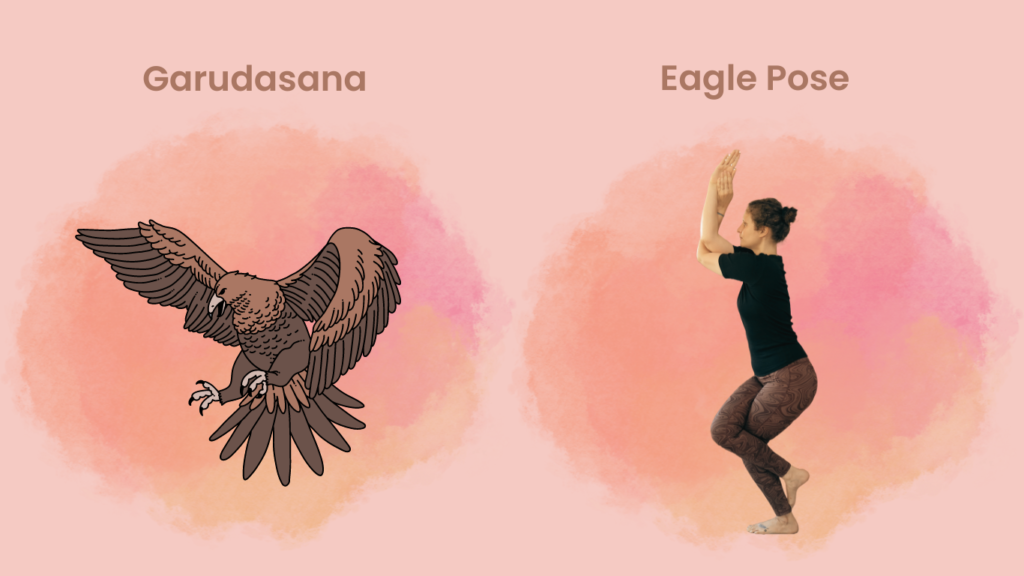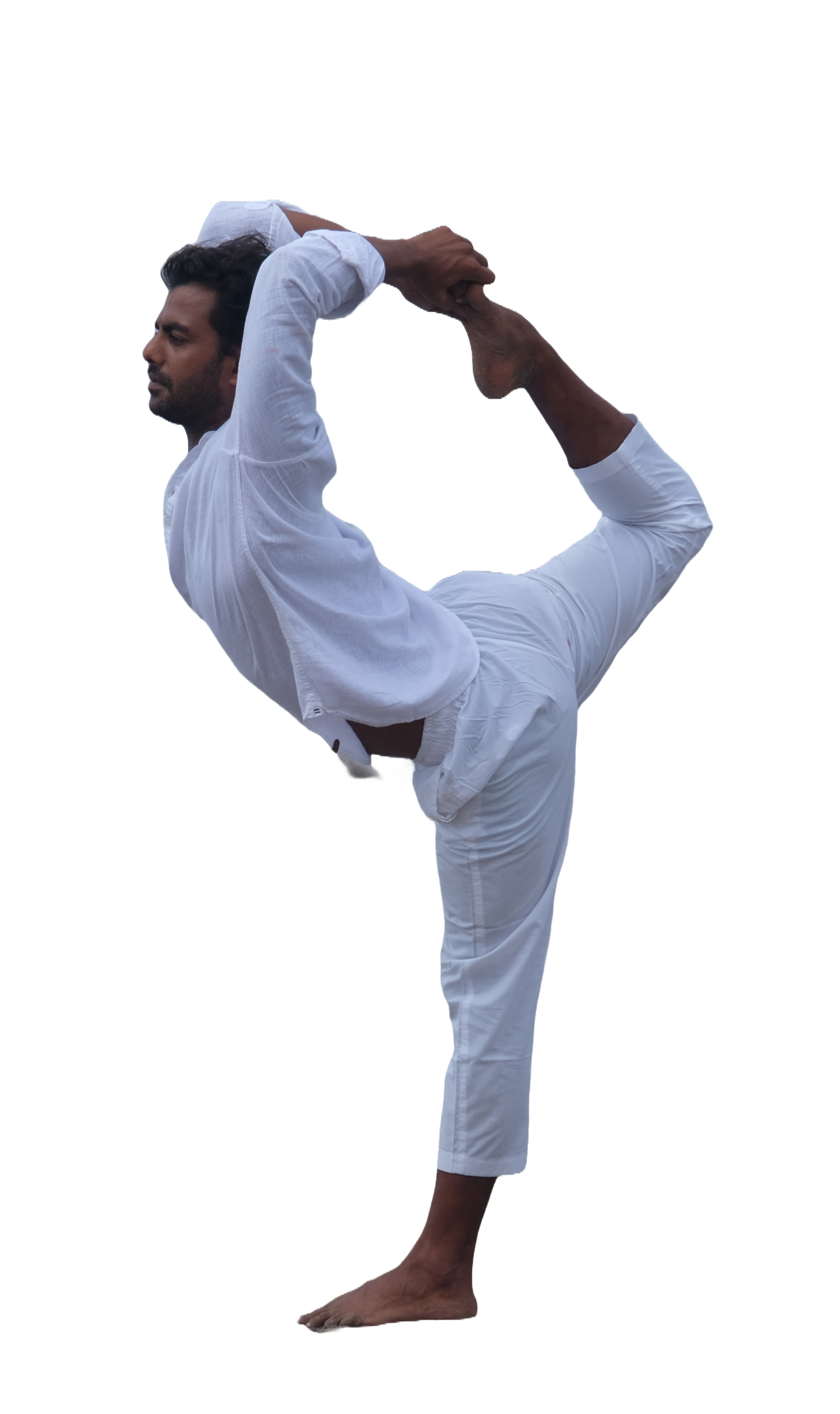
How to do Eagle Pose
Eagle Pose – How to do Garudasana?
Sanskrit: गरुडासन
Garudasana, or Eagle Pose, is a standing balancing pose that embodies the grace and strength of the eagle. The name “Garudasana” is derived from the Sanskrit words “Garuda,” which means eagle, and “asana,” which means pose. Garuda is a mythical bird and the king of all birds in Hindu mythology, often depicted as the mount (vahana) of Lord Vishnu.
The story of Garuda is rich in symbolism. According to Hindu mythology, Garuda was born with immense strength and the ability to fly great distances. His mother, Vinata, was enslaved by her sister Kadru due to a lost bet. Garuda undertook a perilous journey to obtain the nectar of immortality (Amrita) to free his mother. This journey symbolizes determination, focus, and the power of overcoming obstacles. Practicing Garudasana invokes the qualities of Garuda—steadiness and a strong determination to rise above challenges.
Steps to Perform Garudasana (Eagle Pose)
1. Start in Tadasana:
– Stand tall with your feet together and arms by your sides. Ground yourself firmly into the floor.
2. Bend Your Knees:
– Bend your knees and shift your weight onto your right foot.
3. Cross Your Left Thigh Over Your Right Thigh:
– Lift your left leg and cross it over your right thigh. Hook your left foot around the back of your right calf if possible.
4. Wrap Your Arms:
– Extend your arms straight forward, parallel to the ground. Cross your right arm over your left arm at the elbows.
– Bend your elbows, bringing your palms to touch or pressing the backs of your hands together if your palms can’t meet.
5. Find Your Balance:
– Focus your gaze on a fixed point in front of you to help maintain balance.
– Sink your hips lower to deepen the stretch and engagement in your legs.
6. Hold the Pose:
– Hold the pose for 5-10 breaths, maintaining steady and even breathing. Feel the stretch in your shoulders, upper back, and legs.
7. Release and Switch Sides:
– Slowly unwind your arms and legs, returning to Tadasana.
– Repeat the pose on the opposite side, with the left foot as the standing leg and the right leg crossed over it.
Benefits of Garudasana (Eagle Pose)
1. Improves Balance and Concentration:
– Balancing on one leg enhances proprioception and focus, improving overall stability and concentration.
2. Strengthens Legs and Ankles:
– The pose strengthens the muscles of the standing leg, including the ankles, calves, and thighs.
3. Stretches Shoulders and Upper Back:
– Eagle pose provides a deep stretch to the shoulders, upper back, and arms, relieving tension in the trapezius and improving flexibility.
4. Enhances Coordination:
– The pose requires coordination of the limbs, promoting better body awareness and control.
5. Stimulates Circulation:
– The binding action of the pose helps to stimulate blood flow and circulation in the joints and muscles.
6. Promotes Mental Clarity:
– The concentration required to maintain the pose fosters mental clarity and mindfulness, reducing stress and anxiety.
Contraindications for Garudasana (Eagle Pose)
1. Knee Injuries:
– Individuals with knee problems or injuries should avoid deep knee bending and the wrapping action of the legs.
2. Ankle Issues:
– Those with ankle injuries or instability should practice with caution to avoid putting excessive strain on the ankle joints.
3. Shoulder Problems:
– If you have shoulder injuries or limited range of motion, be mindful of the arm position and avoid forcing the wrap.
4. Balance Issues:
– Practitioners with balance issues should use a wall or chair for support to prevent falls.
5. Pregnancy:
– Pregnant women should practice with caution, using a wall or chair for support.
Tips for Beginners
1. Use a Wall for Support:
– Practice near a wall for added stability.
2. Modify the Pose:
– If you cannot hook your foot around your calf, simply cross the legs and place your toes on the ground for support.
3. Focus on Alignment:
– Keep your spine straight and avoid leaning forward. Engage your core to maintain stability.
4. Take It Slow:
– Progress gradually, focusing on maintaining balance rather than achieving the full expression of the pose.
5. Breathe Steadily:
– Maintain a steady and even breath to help with balance and relaxation.
Learn Other Poses:
Popular Courses in Bali
200 hour Yoga Teacher Training in Bali | 300 hour Yoga Teacher Training in Bali | 500 hour Yoga Teacher Training in Bali | 50 Hours Yin Yoga Training in Bali | 50 hours Pranayama Training in Bali | 50 hours Yoga Nidra Training Bali | 50 hours Arm Balancing Training Bali | 100 hour Ashtanga Training Bali
Popular Courses in Germany
200 hour Yoga Teacher Training in Germany | 300 hour Yoga Teacher Training Germany | 50 Hour Yin Yoga Training Germany | 50 Hour Pranayama Training Germany | 50 hour Yoga Nidra Training Germany | 50 Hour Arm Balancing Training | 100 hour Ashtanga Training Germany

